
A rodeo clown, bullfighter or rodeo protection athlete, is a rodeo performer who works in bull riding competitions. Originally, the rodeo clown was a single job combining "bullfighting" — the protection of riders thrust from the bull, as well as being an individual who provided comic relief. Today, the job is split into two separate ones: bullfighters who protect the riders from the bull, and entertainers (barrelmen) who provide comic humor. However, in some parts of the world and at some small rodeos, the jobs of bull rider protection and comic remain combined.
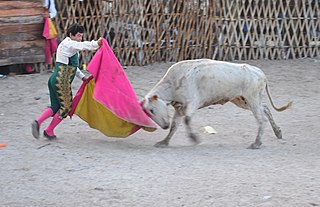
A bullfighter is a performer in the activity of bullfighting. Torero or toureiro, both from Latin taurarius, are the Spanish and Portuguese words for bullfighter and describe all the performers in the activity of bullfighting as practised in Spain, Portugal, Mexico, Peru, France, Colombia, Ecuador, Venezuela and other countries influenced by Portuguese and Spanish culture. The main performer and leader of the entourage in a bullfight, and who finally kills the bull, is addressed as maestro (master), or with the formal title matador de toros. The other bullfighters in the entourage are called subalternos and their suits are embroidered in silver as opposed to the matador's gold. They include the picadores, rejoneadores, and banderilleros.

Ronda is a town in the Spanish province of Málaga. It is located about 105 km (65 mi) west of the city of Málaga, within the autonomous community of Andalusia. Its population is about 35,000. Ronda is known for its cliffside location and a deep canyon that carries the Guadalevín River and divides the town. It is one of the towns and villages that are included in the Sierra de las Nieves National Park.

Tordesillas is a town and municipality in the province of Valladolid, Castile and León, central Spain. It is located 25 kilometres (16 mi) southwest of the provincial capital, Valladolid at an elevation of 704 metres (2,310 ft). The population was c. 8,760 as of 2021.

The Plaza de Toros de Ronda is a Bullring in Ronda, it has a diameter of 66 metres (217 ft), surrounded by a passage formed by two rings of stone. There are two layers of seating, each with five raised rows and 136 pillars that make up 68 arches. The Royal Box has a sloping roof covered in Arabic tiles. The design of the main entrance to the bull ring features two Tuscan columns and the royal shield of Spain surround by baroque edging. The main door is large enough to allow horses and carriages to enter the ring, and above the door is an iron wrought balcony that embodies the bullfighting culture.

Francisco Romero (1700–1763) was a significant Spanish matador. He reputedly introduced the famous red cape (muleta) into bullfighting in around 1726.

Pasodoble is a fast-paced Spanish military march used by infantry troops. Its speed allowed troops to give 120 steps per minute. This military march gave rise recently to a modern Spanish dance, a musical genre including both voice and instruments, and a genre of instrumental music often played during bullfight. Both the dance and the non martial compositions are also called pasodoble.
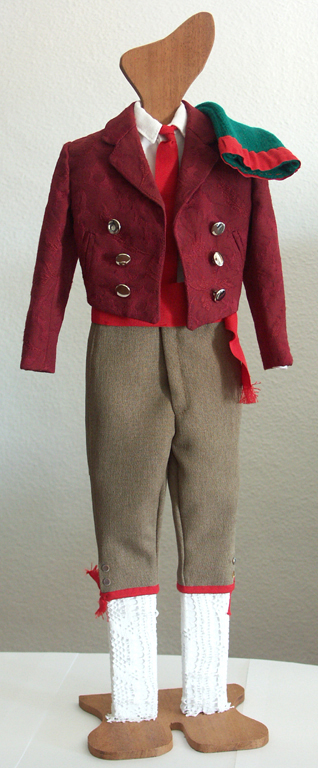
A forcado is a member of a group of men that performs the pega de cara or pega de caras, the final event in a typical Portuguese bullfight. The only Spanish-style bullfighting where forcados may also be present are Mexican bullfights. Forcados were initially professionals from lower classes but nowadays people from all social backgrounds practice their art through amateur groups.

The Spanish Fighting Bull is an Iberian heterogeneous cattle population. It is exclusively bred free-range on extensive estates in Spain, Portugal, France and Latin American countries where bull fighting is organized. Fighting bulls are selected primarily for a certain combination of aggression, energy, strength and stamina. In order to preserve their natural traits, during breeding the bulls rarely encounter humans, and if so, never encounter them on foot.
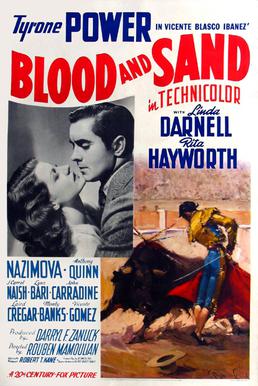
Blood and Sand is a 1941 American romantic Technicolor film starring Tyrone Power, Linda Darnell, Rita Hayworth, and Nazimova. Directed by Rouben Mamoulian, it was produced by 20th Century Fox and was based on the 1908 Spanish novel Blood and Sand by Vicente Blasco Ibanez. The supporting cast features Anthony Quinn, Lynn Bari, Laird Cregar, J. Carrol Naish, John Carradine and George Reeves. Rita Hayworth's singing voice was dubbed by Gracilla Pirraga.

Spanish-style bullfighting is a type of bullfighting that is practiced in Spain, Mexico, Colombia, Ecuador, Venezuela, Peru, as well as in parts of southern France and Portugal. This style of bullfighting involves a physical contest with humans attempting to publicly subdue, immobilize, or kill a bull. The most common bull used is the Spanish Fighting Bull, a type of cattle native to the Iberian Peninsula. This style of bullfighting is seen to be both a sport and performance art. The red colour of the cape is a matter of tradition – bulls are color blind. They attack moving objects; the brightly-colored cape is used to mask blood stains.

Navas de San Juan is a Spanish village of the province of province of Jaén, Spain. According to the 2005 census (INE), the city has a population of 5,030 inhabitants. It is the biggest village in the region of El Condado. The river called Guadalimar runs for its municipal area.
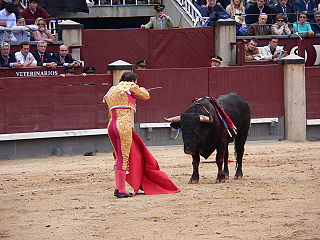
Bullfighting is a physical contest that involves a bullfighter attempting to subdue, immobilize, or kill a bull, usually according to a set of rules, guidelines, or cultural expectations.
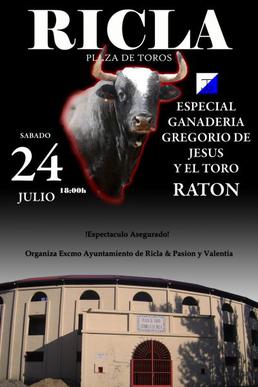
Ratón was a Spanish fighting bull that was nicknamed el toro asesino, el sangriento toro Raton and el terrible Ratón for killing three people in bullfighting rings in Spain during 2006–2011 and injuring thirty more. The bull became legendary in Spain due to the large number of gorings for which he was responsible. Bullfighting fans regarded him as a star and traveled from across the country to see the morlaco at his home at Sueca near Valencia. Matador Jesús Esteve said of Ratón: "He is a killer. He is lazy, he doesn't want to participate. He does his own thing, waiting for somebody to make a mistake. And then when he gets you, he wallops you, and he doesn't let up."
Bullfighting was banned in the Spanish autonomous community of Catalonia by a vote of the Catalan Parliament in July 2010. The ban came into effect on 1 January 2012. The last bullfight in the region took place on 25 September 2011 at La Monumental. The ban was officially annulled for being unconstitutional by Spain's highest court on 5 October 2016. However, despite the overturning of the ban, no further bullfight had taken place in Catalonia as of July 2020.
The major sports in Venezuela are baseball, basketball and football. Baseball in Venezuela originates with the early 20th century cultural influence of the United States oil companies. The Venezuelan Professional Baseball League was established in 1945. Football in Venezuela lags behind baseball, but its popularity in recent years has grown. Basketball and volleyball are also popular sports; there has been a national basketball league since 1974. The Vuelta a Venezuela is one of six cycling events in the UCI America Tour. The polo club Lechuza Caracas has had some success in North American polo competitions.
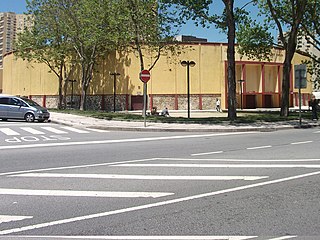
Póvoa de Varzim Bullfighting Arena was a bullring in Póvoa de Varzim, Portugal. It is located on Avenida Vasco da Gama, on the northern waterfront of the city. Bullfighting, horse shows, and concerts are held in the arena.
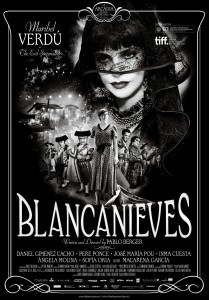
Blancanieves is a 2012 Spanish black-and-white silent drama film written and directed by Pablo Berger. Based on the 1812 fairy tale Snow White by the Brothers Grimm, the story is set in a romantic vision of 1920s Andalusia. However, the film approaches storytelling through the integration of Spanish culture from characters' names to traditions they follow. Additionally, the film alludes to other fairy tales including Cinderella and Little Red Riding Hood. While it retells stories originally told through tales based in fantasy, it derails from the traditional storytelling method that ends with a happily ever after. Instead, the film is rather dark and ends in tragedy. Berger calls it a "love letter to European silent cinema."

Bullfight is an 1824 oil painting by Goya owned since 1992 by the J. Paul Getty Museum. When the museum bought the painting at auction in 1992, it shattered the artist's previous auction record. This piece shows Goya’s favorite form of entertainment: the controversial contest of bullfighting.
The Bulls of Bordeaux is a series of four lithographs featuring scenes of bullfighting by the Spanish painter and printmaker Francisco Goya, produced in 1825 during his exile in France. Unlike the series La Tauromaquia which dealt with the performers in bullfighting, The Bulls of Bordeaux deals with bullfighting as a popular spectacle.


















